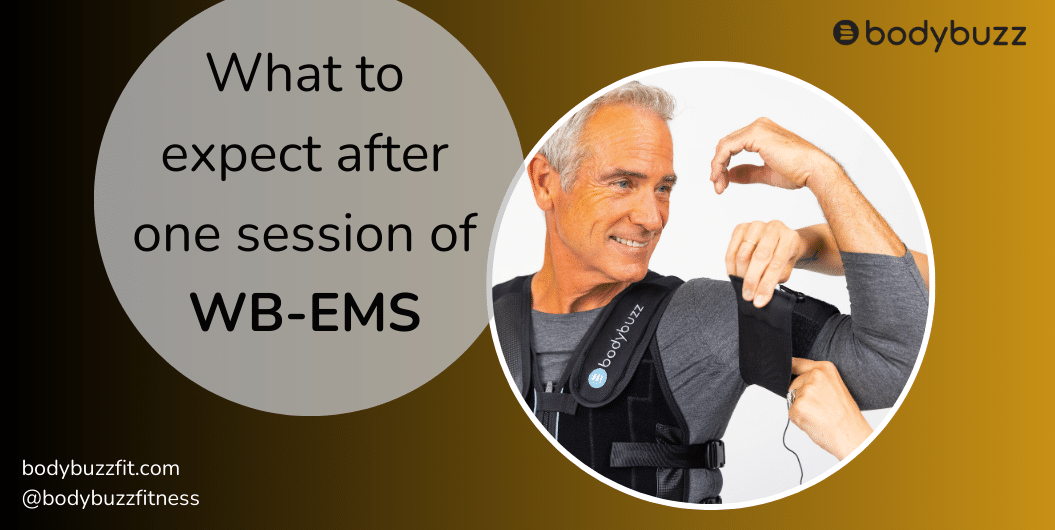What to expect after one session of EMS
Congratulations! You’ve booked your first WB-EMS appointment!
The first session is primarily designed for you to experience an EMS workout: putting on the suit, performing simple movements, likely using a slower tempo than you’re accustomed to, and most interestingly, doing so with stimulation running through your muscles.
After the session, you will feel like your muscles are more activated. This is due to your nervous system being stimulated by the impulses from the EMS suit. What you probably won’t feel too much is being tired. I remember after my first session I thought I had basically just completed a 20 minute warm-up and now felt ready to go workout. However, I followed the coach’s instructions and didn’t lift any weights that day or the day after.
The day after an EMS session you may still not feel much. In fact, most people do not start feeling any soreness until a full 2 days later. Some people feel very sore after their first session and others not as much. Either way, soreness is not always a good indicator of an effective workout. You can read more about muscle soreness here.
What else can you expect? Even though your first electrical muscle stimulation session may not feel very intense, internally your body may have a different opinion. The biggest risk with EMS workouts are the rapid increase in creatine kinase (CK) levels, an enzyme that needs to be processed through the kidneys that mirrors that of very intense exercise such as running a Marathon. Learn more about the risks and safety of EMS fitness here.
Luckily… we have some research to ease our worries!
This research study aimed to evaluate the acute effects of a single session of whole-body electromyostimulation (WB-EMS) combined with classic resistance training on isometric and endurance strength, as well as flexibility in active women. Additionally, the study assessed the safety of this protocol by monitoring CK levels 48 hours post-training. Sixteen active women aged around 22 years were randomly assigned to an experimental EMS group (EMSG) and a control group (CG). The EMSG performed resistance exercises with WB-EMS, while the CG performed the same exercises without WB-EMS.
Experimental EMS Group (EMSG):
Performed voluntary strength exercises including full squat, hip thrust, and Romanian deadlift. Each exercise was performed in 4 sets of 12 repetitions.
There were 90 seconds of rest between sets and 2 minutes of rest between exercises. During each repetition, 4 seconds of stimulation occurred during the isometric contraction at the point of transition between the eccentric and concentric phases of the movement. The stimulation parameters were 85 Hz, 350 µs, 4 seconds of stimulation/4 seconds of rest. Stimulation intensity was set to reach a level of 6–7 out of a maximum of 10 on the rate of perceived exertion (RPE).
Control Group (CG):
Performed the same strength exercises as the EMSG including full squat, hip thrust, and Romanian deadlift. Performed the same number of sets and repetitions: 4 sets of 12 repetitions. Used the same rest intervals of 90 seconds between sets and 2 minutes between exercises. This group had no superimposition of WB-EMS during the exercises.
Both groups performed the same exercises and the same number of sets and repetitions, with the only difference being the superimposition of WB-EMS in the experimental group.
The results showed significant improvements in isometric and endurance strength, particularly in the posterior kinetic chain extensors, and flexibility in the EMSG compared to the CG. Notably, CK levels remained within the normal range, indicating the safety of the protocol. These findings suggest that WB-EMS combined with resistance training can lead to immediate improvements in strength and flexibility without adverse effects on CK levels, making it an effective and safe training strategy for active women.
Anecdotally, I have a client who will bend over to touch her toes systematically after each session to test her flexibility, followed by a smile and a “I usually can’t bend forward this far!”. The focus of her training is not flexibility, so I don’t include any specific exercises for it, this is just a bonus that comes along with strength training.
Ready to book your first EMS session?
If you want to learn more about EMS, book a free consultation with me here: https://calendly.com/conradfitness/30min. You can also make an appointment to book an intro session at our Newport Beach studio.

